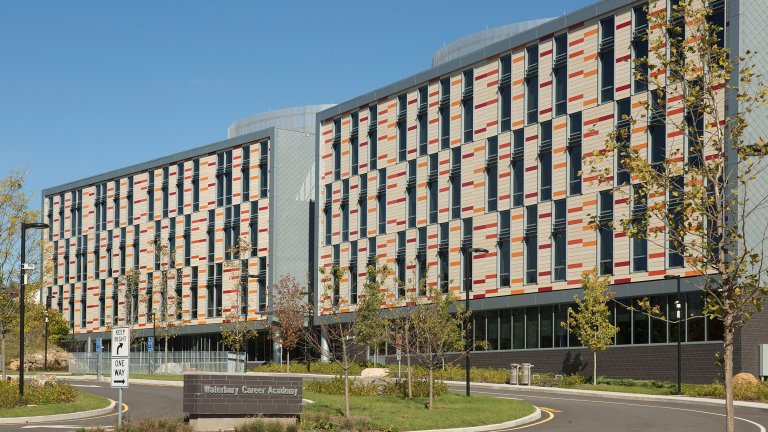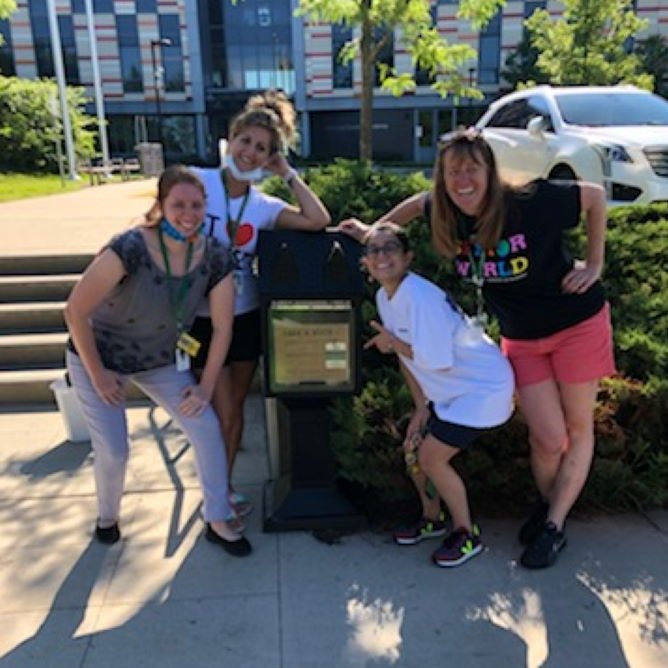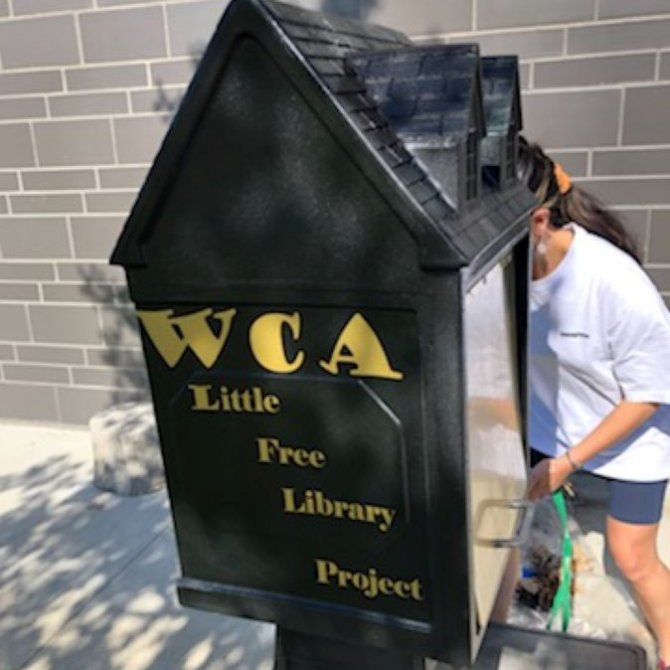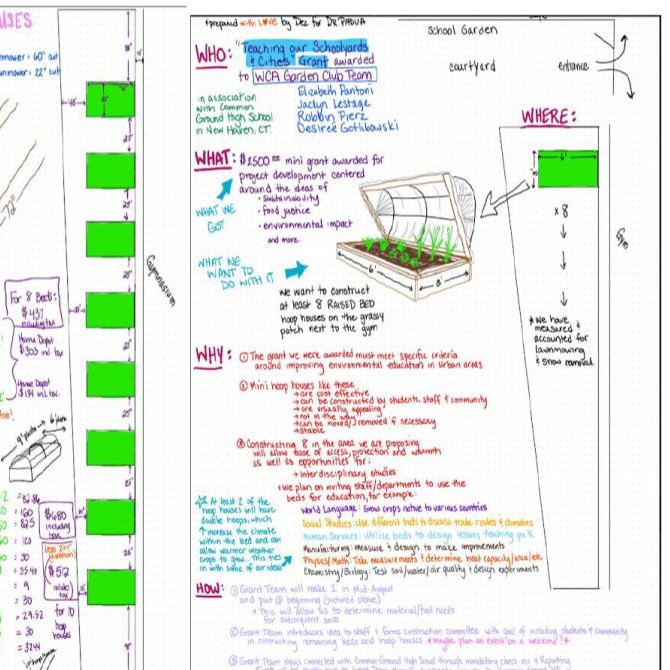
School Context
Waterbury Career Academy (WCA) is an application-based public school teaching grades 9-12 within the city of Waterbury. Only city residents can attend the school, so all of our students reside in Waterbury. The school opened its doors in 2013 with a focus on four career strands: IT, Health, Human Services, and Manufacturing. Our goal is to prepare students for colleges and careers within their strand. The school currently serves 792 students, and we hope to help our students make interdisciplinary connections both in school and within our city community through this project.
Curricular Context (All Grade Levels, All content-areas)
This project is bringing students and the community together through an interdisciplinary lens -- creating and stewarding upcycled Little Free Libraries that share environmental content, reused books, and other resources across our Waterbury community. Our project team consists of four teachers from four different disciplines -- Biology, Chemistry, Spanish, and Human Services -- and so these subjects are our starting point. We are encouraging other teachers, clubs, and athletic teams to “adopt a box,” as well -- expanding into a school-wide project that will connect across multiple subjects while aligning to the curricula that each subject area follows. In this way, the Little Free Libraries project can connect to many different classes over many years.
This project profile was created by Elizabeth Pantoni, Desiree Gotlibowski, Robbin Pierz, and Jacqueline Lestage, all teachers at Waterbury Career Academy, working in partnership with Common Ground's Schoolyards Program, and Teaching Our Cities.
Environment

Our mission is to be a catalyst for building community, encouraging environmental stewardship, and expanding book access for all through the strategic placement of 10 Little Free Libraries throughout the city of Waterbury. We want to be able to reach our entire community by both exposing them to and providing autonomous opportunities for our members to engage with urban environmental issues in a literacy context.
Our team's passions include sustainability, gardening, and food equity within our city, and we realized the Little Free Libraries initiative would be a great way to tie all of these ideas together. Traditionally, Little Free Libraries focus on book sharing and literacy; in addition to this, our project aims to engage the community with seed sharing, student-created brochures, and literature surrounding environmental issues. We hope that our little free libraries will grow into student-created resources for helping city residents of all ages explore urban environmental issues and access resources that help them address these issues!
This project is upcycling and reusing resources that are likely to otherwise to go to waste, helping to address an environmental challenge facing Waterbury and other cities. We have been lucky to connect with amazing community partners: The local newspaper (The Republican American) donated some old newspaper stands that we are able to convert into Little Free Libraries. The Little Free Library organization also donated some old real estate boxes, as well. Many of the books shared through the project will be used ones, helping keep them out of the waste stream.
We started close to home, with a little free library right outside the main entrance to our school. On field day last year, we worked together with the senior class to prepare one of these boxes as a prototype to place in front of our own school building. Our prototype has been very popular with local families. We are placing books for readers of all ages, aiming at making literacy and environmental information in particular available to all of our neighbors in Waterbury. Many teachers have seen groups of families taking books on environmental justice and environmental issues.
Our project expands out into the larger city -- focusing on locations in city parks, where city residents already travel to access natural environments in their cities. We have met with the Waterbury Parks and Recreation Department to see where we can place the remaining boxes, and at this time we have a plan to place the boxes in various parks throughout the city.
This experience will deepen students’ connections to our Waterbury community through the upkeep, management, and provision of resources in their neighborhoods. At this time, the Human Services students are take a lead in our Little Free Library collaboration. They are creating lesson plans aligned with the Educator Rising curriculum to deliver to the community through Little Free Library boxes. This learning lab will have several components leading up to the delivery of lessons at the LFL boxes once they are in place in the parks. Students will also be required to reflect on the project at the end of this year-long project.
Expectations
Our "Adopt a Box" model is designed to allow students to build mastery of skills and concepts from a variety of disciplines. Curating the content of a Little Free Library, creating brochures and digital content that can be accessed via QR codes at the boxes, analyzing the use and siting of the libraries, maintaining these community resources, and creating plans for community lessons held at the location of the Little Free Libraries each push students to build and demonstrate different skills and understandings. For instance, students in a Spanish class can practice, apply and demonstrate communication in writing by selecting Spanish language texts (including texts relevant to environmental issues), and by creating Spanish language signage and resources for the little free libraries. Here are examples of how we are connecting this project to priority standards in our courses:
- HS-LS2-7 Ecosystems: Interactions, Energy, and Dynamics: Design, evaluate, and refine a solution for reducing the impacts of human activities on the environment and biodiversity.*
- Example: Chemistry Unit 4- ocean acidification, air pollution/gasses, carbon cycle, energy efficiency- have students research a problem/identify solutions- collect synopsis of student work on google website and connect this to the Little Free Library via a QR code, or create paper "solution guides" to be distributed through the little free libraries.
- HS-ESS3-6 Earth and Human Activity: Use a computational representation to illustrate the relationships among Earth systems and how those relationships are being modified due to human activity.
- Example: Students collect data on what books/information are taken out, and use visual representations of data to demonstrate a variety of trends (topics of interest, number of books/pamphlets taken/ language of books) to determine what books are most appropriate for the boxes.
- HS-ETS1-3 Engineering Design: Evaluate a solution to a complex real-world problem based on prioritized criteria and trade-offs that account for a range of constraints, including cost, safety, reliability, and aesthetics as well as possible social, cultural, and environmental impacts.
- Example: As an end of year project in Chemistry, students design their own tiny home, with a focus on energy efficiency, the impact of materials uses, and other design factors. As part of this activity, they can design a new set of little free libraries that reflect efficient and sustainable design.
- Educator Rising National Standards: Describe the school and community resources available to support student growth in the classroom and beyond. Describe how accomplished teachers leverage school and community resources to support individual students and extend learning beyond the classroom. Cross-cutting Theme(s) Alignment, Reflective Practice, Collaboration, Self-efficacy, Educators Rising Standard(s) Alignment, II: Learning About Students., V: Engaging in Responsive Planning, VII: Engaging in Reflective Practice.
- Example: Educator Rising students will create lesson plans to be delivered at the site of the Little Free Libraries, and create resource guides about community environmental resources that can be shared through the Little Free Libraries
This project has a larger educational purpose, as well: helping promote literacy and environmental literacy in community, as we collect, create, and share books and other resources that will target people of all ages and abilities.
Exhibition

Our goal is to create an interdisciplinary project menu that will allow our staff and students to engage with our Little Free Library Initiative. We want to provide our staff with the opportunity to “explore the possibilities” of content-area projects that can promote environmental awareness, literacy skills and community improvement. Our project will initiate with the placement of our 10 upcycled newspaper box stands at our local parks. Following their placement, our school groups and clubs will claim “ownership” over a registered Free Little Library box that is filled with donated multilingual literature. Each student group will be led by a teacher, club supervisor or coach that will guide and facilitate interdisciplinary learning opportunities/projects through their “adopted” Free Little Library.
Students have a real audience for their work: The residents of the city they call home! Their work is also making a real impact on their urban environment: by reclaiming resources that would otherwise go to use, and by sharing literacy and environmental literacy resources with their neighbors in Waterbury. Students will apply learning across various subjects through project. For instance:
- Spanish: Juniors will create a children’s story that tells/describes a nature scavenger hunt using their Spanish environmental vocabulary. The students will investigate one of the local Waterbury parks where a Little Free LIbrary has been placed. They will create/design a directory map of their chosen park in Spanish, which can later be added to their digital stories they are creating in this class. Students will also investigate environmental factors within that park that may impact the community. Students will interview/survey people from that neighborhood/park in Spanish on environmental awareness issues. Students might also create a social media page for their “themed” Spanish Class Little Free Library that could include: environmental awareness posts, book box updates, monthly treat drop-off notices, QR codes date, etc.
- Biology: This project can reflect NGSS standard HS-LS2-7 (HS-LS2-7 Ecosystems: Interactions, Energy, and Dynamics: Design, evaluate, and refine a solution for reducing the impacts of human activities on the environment and biodiversity) because we will be reusing old newspaper and real estate stands. Repurposing or “upcycling” products such as these helps promote sustainable practices and offers one solution of reducing the negative impact that human waste has on the ecosystem and biodiversity. In urban environments, showcasing the process of upcycling materials like this can have a dramatic effect on the community as a demonstration of how individuals can have a positive impact on their ecosystem. Furthermore, students can observe and collect data about how the placement of the Little Free Library within an ecosystem impacts the flora and fauna in the area, and use that data to make adjustments or modifications that aims to improve the ecosystem. For example, students can document the wildlife they observe in the area around the Little Free Library over time and discuss how the LFL may be impacting changes, if there are any. They can then brainstorm ways of fixing any issues that may come up, thus reinforcing skills like observation, data collection and analysis as well as communication.
- Chemistry: This project can reflect NGSS standard HS-ETS1-3 (Engineering Design: Evaluate a solution to a complex real-world problem based on prioritized criteria and trade-offs that account for a range of constraints, including cost, safety, reliability, and aesthetics as well as possible social, cultural, and environmental impacts.) In unit 4, students have a culminating task of designing a tiny home. In addition to the tasks they need to complete to satisfy the needs of the curriculum project, groups of students can design a website page attached to the QR code with information about low cost energy solutions, environmentally friendly designs/appliances, upcycling of furniture, composting, garden designs/tips, and more. If each group focuses on a specific topic, the pages could be diverse and informative.
- Human Service: Students in our Human Service Career Strand will use the Little Free Lbirary as a learning lab. First students will conduct a literature review to identify books that are accessible and relevant to city residents, and that build awareness of important urban environmental issues. Students will research appropriate literature and create rubrics to assess the worthiness of book selection. Students will regularly visit LFL to make sure they are stocked, and in line with other kinds of content ( seed distribution, student created themed pamphlets). Students will be required to create lesson plans aligned with the national Educator Rising curriculum and aligned with urban environmental issues. Finally, students will create, market, and deliver the lesson plans at the LFL to create community, literacy and awareness of environmental concerns.
Experience
The sequence of learning experiences varies across the courses that participate in this school-wide project. Experiences of students in our Human Services career strand provide one example of how students can engage with this Little Free Library project. Human Resources students explore teaching careers and building skills as educators, drawing on resources from Educator Rising, a national curriculum addressing the teacher shortage. The Little Free Libraries project provides a community-based learning laboratories in which these students can build skills as environmental educators.
- Students make an initial visit to the Little Free Libraries created through the project -- assessing their condition, reviewing content, understanding how they work.
- Students conduct a literature review to identify books that address urban environmental issues and are accessible to residents of our local community. They create rubrics to assess potential book selections, and use these rubrics to choose the resources they will include in their library.
- Students make regular visits to the Little Free Libraries to make sure they are stocked, and to support the roll-out of other resources ( seed distribution, student created themed pamphlets on environmental themes)
- Finally, students will create, market, and deliver the lesson plans at the LFL to create community, literacy and awareness of environmental concerns.
The culmination of implementing our 10 Little Free Libraries throughout the city of Waterbury will be a celebration to coincide with Earth Day. Creating community through a city wide celebration of our project will help promote multilingual literacy around the environment, as well as bring attention to our project and allow students' work to be showcased.
Reflections

Our project is still in progress -- so we are still learning!
Early on, we learned the value of prototyping before going to scale. This Little Free Library project was our team's Plan B. We began with an effort to create mini-greenhouses, providing extended season growing on top of raised bed gardens on our campus. We learned the value of setting up a demonstration project, and prototyping before going fully to scale! We built an initial raised bed in a prominent location in front of our school, to build awareness and buy-in for our project. Unfortunately, a member of our school leadership at the time didn't share our excitement about the beauty and educational value of this project, and we had to pivot before bringing our project to scale. We had only spent a small portion of our mini-grant funds, and still had plenty of time left in the school year, so were able to shift direction.
Over the pandemic, we also learned the value of moving learning and student products out into the environment into our communtity. The pandemic slowed down our project, but also made it more relevant. Providing books in public parks and other outdoor locations put environmental resources and literature within reach at a time when many people were hesitant to go inside buildings, and when school buildings were closed. By starting in front of our school building, we once again worked to put this project front and center in the life of our school community, so that other teachers and students could see it, and we could build toward our school-wide vision.
